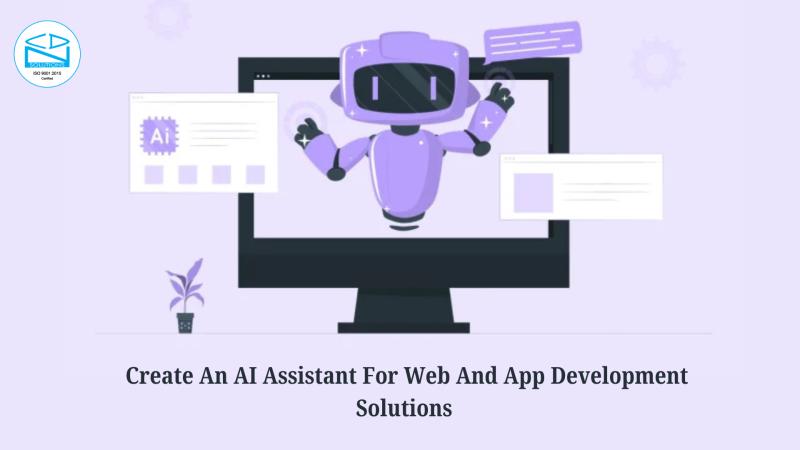How To Create An AI Assistant For Web And App Development Solutions

As an IT Solutions Company, CDN Solutions always makes our developers push the boundaries of technology, in today's changing scenario and new technologies AI assistants have become integral to improving efficiency and user experience in web and app development solutions. AI assistants can automate tasks, enhance decision-making, provide intelligent suggestions, and offer real-time support. If you're looking to create an AI assistant which helps your business to grow with web and app development solutions, have a look at some of the points you need to remember according to which
Before diving into the development, defining what AI assistants will do is essential. Will it help developers by suggesting code snippets? Will it offer troubleshooting assistance for app bugs? Or will it provide real-time feedback during website design? The possibilities are vast, but your first task is to narrow down the core functions like
- Automated Code Generation
- Debugging Assistance
- UI/UX Design Aid
- Performance Analytics
- User Support Chatbots
What Is AI Assistant and Its Types
An AI assistant is a software application or system powered by artificial intelligence that can perform tasks, provide information, or assist users in achieving specific goals through natural language interactions or automated workflows. AI assistants leverage technologies like natural language processing (NLP), machine learning (ML), and sometimes computer vision to understand user input and provide relevant, context-based responses or actions.
In web and app development, AI assistants are designed to help developers by automating repetitive tasks, generating code, troubleshooting issues, managing projects, and enhancing overall productivity.
Types of AI Assistants
Virtual Personal Assistants (VPAs): These AI assistants, like Siri, Alexa, and Google Assistant, interact with users via voice commands or text. They assist in everyday tasks like setting reminders, managing schedules, and answering questions, making life more efficient for users.
Task-Specific AI Assistants: These assistants are built for specialized tasks, such as providing customer service (e.g., chatbots) or helping developers write and debug code. A task-specific AI assistant might help with code generation, error detection, or project management in web and app development.
Collaborative AI Assistants: These assistants support teams by enhancing communication and collaboration. They integrate with project management tools like Jira or Asana, automate workflows, and help teams stay organized. In development environments, they can assign tasks, track project progress, and report on bottlenecks.
Conversational AI Assistants: Often referred to as chatbots, these AI assistants conversationally interact with users, simulating human-like dialogue. Developers might use these assistants to troubleshoot issues, retrieve documentation, or get advice on best practices directly from within their development environment.
Integrated Development AI Assistants: These are designed for coding and development environments. Tools like GitHub Copilot fall under this category, offering auto-completion of code, suggestions for improving code structure, and even finding bugs in real time.
Benefits of AI Assistant In IT Solutions
AI assistants are transforming the IT landscape by enhancing efficiency, automating repetitive tasks, and providing intelligent insights to drive better decision-making. In the context of IT solutions, AI assistants can play a pivotal role in simplifying complex processes and boosting productivity. Here are some key benefits of integrating AI assistants in IT solutions:
1. Increased Productivity and Efficiency
AI assistants can automate routine and repetitive tasks, such as scheduling, coding, testing, or troubleshooting, allowing IT professionals to focus on more critical, high-value tasks.
2. Error Reduction and Quality Improvement
One of the biggest advantages of AI assistants in IT solutions is their ability to reduce human errors. In coding environments, for example, an AI assistant can detect syntax errors, security vulnerabilities, or logic issues early on, preventing costly mistakes.
3. Faster Decision-Making
AI assistants can analyze vast amounts of data quickly, offering insights and recommendations in real time.
4. Enhanced User Support and Troubleshooting
For IT support teams, AI-powered virtual assistants can provide first-level technical support, resolving common issues like password resets, software configuration problems, or network issues without human intervention.
5. Scalability and Adaptability
AI assistants can scale as businesses grow, adapting to increasing workloads and evolving IT infrastructures. They can handle more requests, analyze larger datasets, and support more users without additional human resources.
6. Improved Collaboration
AI assistants can integrate with collaboration and project management tools, facilitating better team coordination in IT projects.
СHALLENGES OF Making AI ASSISTANT DEVELOPMENT
While AI assistants offer immense benefits, developing an effective AI assistant, especially for web and app development, comes with its own set of challenges. These challenges span technical, operational, and ethical dimensions, making the development process complex and requiring careful planning. Here are some of the primary challenges faced when building AI assistants:
1. Data Availability and Quality
AI assistants rely heavily on data to function effectively, but gathering the right kind and volume of data can be challenging. In the context of web and app development, an AI assistant needs access to high-quality datasets, such as code repositories, bug reports, and user feedback. Inadequate or biased data can lead to poor performance, inaccurate predictions, or inappropriate responses, which can undermine the effectiveness of the assistant.
2. Natural Language Processing (NLP) Complexities
For an AI assistant to understand and interact with users naturally, it must be proficient in NLP. However, language is inherently complex and nuanced. Interpreting developer commands, understanding context, and distinguishing between similar terms in a technical environment can be difficult. Misunderstanding user intent or providing ambiguous responses can frustrate users and decrease the AI assistant's utility.
3. Ensuring Accuracy and Precision
When developing AI assistants, particularly in technical fields like web and app development, accuracy is critical. Incorrect code suggestions, failure to detect errors or inaccurate advice can lead to bugs, security vulnerabilities, or project delays. Ensuring the AI assistant is consistently accurate requires significant training, testing, and ongoing updates, which can be time-consuming and resource-intensive.
4. Integration with Development Tools
To be truly useful, an AI assistant must integrate seamlessly with a variety of development tools, including IDEs (e.g., Visual Studio Code), version control systems (e.g., Git), and project management platforms (e.g., Jira). Ensuring compatibility with multiple platforms and keeping the assistant updated with the latest tool features and changes is a major challenge in development.
5. Scalability and Performance
As user demands grow, the AI assistant must scale to handle increasing workloads. This is especially true for AI assistants used in collaborative environments where multiple developers are interacting with the assistant simultaneously. Ensuring scalability without compromising performance requires careful planning of the system architecture, including load balancing, cloud infrastructure, and data management.
6. Security and Privacy Concerns
AI assistants often require access to sensitive information, such as proprietary codebases, project documentation, and user data. Protecting this information from leaks, breaches, or malicious attacks is critical. Developers must implement robust security protocols, and encryption, and ensure compliance with data protection regulations (e.g., GDPR). Any vulnerabilities in the assistant’s handling of data could lead to significant risks for organizations.
7. Training and Maintenance Costs
Developing an AI assistant involves continuous learning and training. The models must be regularly updated with new data, algorithms, and improvements to stay effective and relevant. This ongoing training can be costly and time-intensive, requiring resources to fine-tune the system as it encounters new problems, programming languages, or development environments.
8. Ethical and Bias Issues
AI systems, including AI assistants, can unintentionally adopt biases present in their training data, which may affect the decisions and suggestions they make. In a development environment, bias could manifest in ways such as favoring certain coding styles, frameworks, or languages over others. Managing ethical issues and ensuring fairness and neutrality in the assistant’s recommendations is essential for its adoption across diverse teams.









Comments